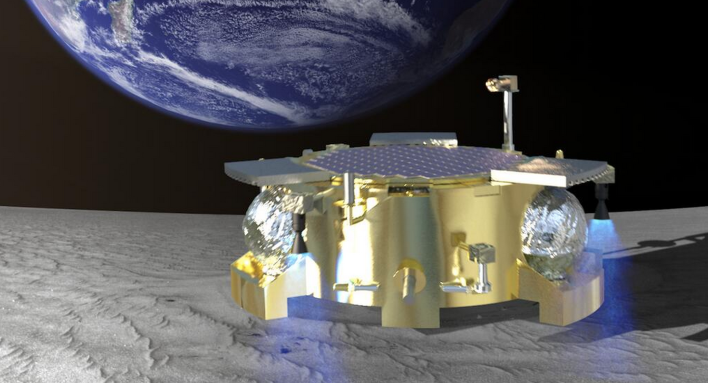.

Penn State’s Moon Mission Launches Crowdfunding Campaign
By the end of 2015, Penn State hopes to complete the first privately funded mission to the moon, ever, for a shot at $20 million in prize money through the Google Lunar X Prize competition. To that end, the Lunar Lion, the Penn State-led Google Lunar X Prize team, has just launched a crowdfunding campaign on Rockethub, with the goal of raising $400,000 by Feb. 25.
This campaign — Penn State’s first major fundraising effort to ever be hosted on a public crowdfunding platform — follows a series of rocket engine tests recently completed by the Lunar Lion, dubbed “Phase 1.” Having now tested the NASA-provided rocket thrusters that will be used to land the Lunar Lion on the moon, the team hopes to move on to the next phase: the development of a working Lunar Lion prototype.
In other words, the Lunar Lion wants to create a preliminary version of its rover, to be tested here on Earth. The team would like to have a working prototype up and running by midsummer.
Creating a prototype moon rover, of course, will require a lot of money. This is where the crowdfunding campaign comes in. $400,000 is a very ambitious goal; for comparison, a recent crowdfunded effort to send a telescope into space required 17,614 donors — averaging $85 a donation — to raise $1,500,000. This means that, to meet its fundraising goal, the Lunar Lion will require either strength in numbers (via the Penn State community and alumni association) or strength in size of donations.
Even if Penn State successfully meets its $400,000 goal, this particular campaign is just the first step toward funding the university’s race to the moon. Testing the Lunar Lion prototype alone will likely exceed $400,000 in costs. A successful moon landing will require a total of $60 million; the university hopes to raise $20 million of that sum through philanthropic efforts such as this Rockethub campaign, according to Steve Blake, Director of Development for Penn State’s research institutes.
(Editor’s note: Of the remaining $40 million that is not accounted for by philanthropic contributions, the university hopes to raise $30 million through corporate contributions. The other $10 million comes from university savings; the Lunar Lion will not be charged overhead for its usage of Penn State facilities.)
To the Lunar Lion, this campaign is not just a fundraising effort; it’s also an opportunity for the public — not just the Penn State community, but also the wider world — to participate in a mission that may well revolutionize space exploration, according to student team leader Ajeeth Ibrahim.
“We want people to know that such massive feats are within their ability to participate and take an active part in,” Ibrahim said. “Showing that students at Penn State are working to make space exploration a reality is one way to show how this is possible.”
Quelle: Onward State
.
Penn State Lunar X Prize team plans to crowdfund its way to the moon
.
What did you accomplish in college? Did you lead a club? Did you even turn in your homework?
At Pennsylvania State University, more than 80 students are pursuing a slightly more noble goal: landing a spacecraft on the moon, and hopefully earning $30 million in the process. The Lunar Lion team is competing in the Google Lunar X Prize, which challenges private teams to land on the moon and then move their craft to a second location at least 500 meters away by the end of 2015.
.

The Lunar Lions’ plan to reach the moon. Graphic courtesy of the Lunar Lions.
.
Lunar Lion director Michael Paul, a former NASA spacecraft systems engineer, said the university asked him to look into opportunities to become more involved in space exploration. Three years ago, he was OK’d to pursue the X Prize.
“I’ve really fallen in love with the idea of building these robots and using them as our eyes and ears around the solar system,” Paul said. “The X Prize stood out as the best way to make a mark on the industry.”
But when you are a student oriented team competing against 33 (now 18) private and national teams, unique challenges emerge. Money is tighter, and turnover is high.
The team began by investigating the most realistic, affordable option to get a lander to the moon.
“One aspect of space systems engineering that is perhaps a little foreign to the average person is the frugality of the engineering,” Paul said. “You don’t send anything up on a launch vehicle that you don’t need to send. You can’t afford it. As you go through the design for any spacecraft for any mission, you repeatedly ask yourself, ‘Do we really need to do this?’”
.

The Penn State Lunar Lions lander. Photo courtesy of the Lunar Lions.
.
One of the major places that mindset came into play for the Lunar Lions was determining how their lander would move 500 meters once it reached the moon. Instead of wheels, they settled on a “hop” system where the lander takes off and lands again. It’s less expensive and doesn’t require a rover or totally new mode of transit to be built into the lander.
As far as turnover goes, Paul said the team is organizing itself to ensure there is continuity as underclassmen replace graduating upperclassmen. In the process, they are hoping to spread that STEM careers can be exciting.
“We want it to be what it was after Apollo,” director of development Steve Blake said. “People went to school so that they could build rocket ships. People went to school so that they could put something on the moon.”
The team launched a crowdfunding campaign today meant to pay for an essential next step in their quest for the moon. They want to raise $400,000 before February 24 to finalize and build their engine, test that the lander can execute its hop, pay for test site fees and materials and compensate students, faculty and engineers for their time. More crowdfunding campaigns are planned.
“The last space X Prize was fantastic in its own way, but they really put the bar high on this one. It requires a whole lot more infrastructure, complexity,” Paul said. “This is hard. This is rocket science.”
Quelle: Gigaom
4839 Views
